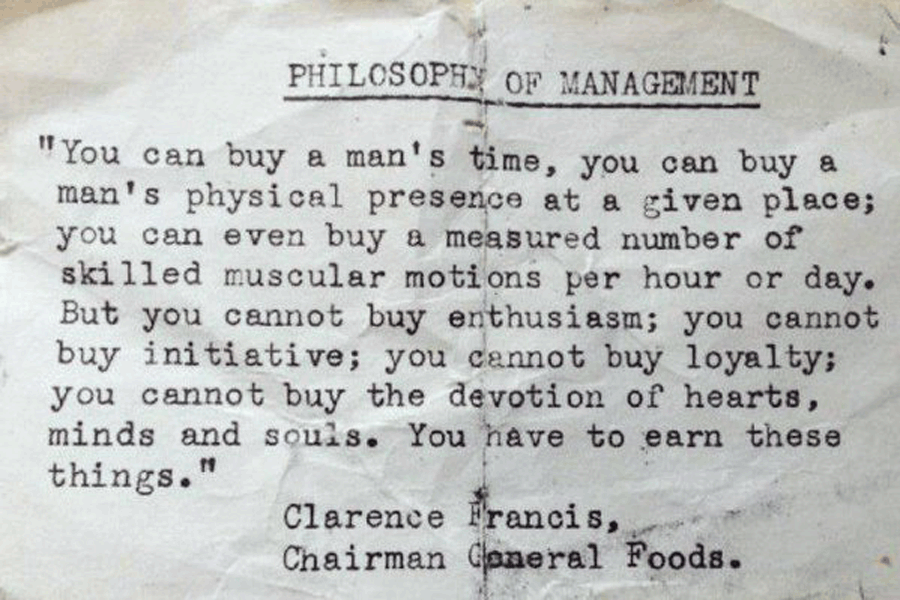Part 3: Doing Our Job as Managers
The New Rules for Employee Engagement
Part 3: Doing Our Job as Managers
We generally know and accept that managers have the greatest day-to-day impact on employee engagement. Yet, even our best managers are increasingly pressed and finding it harder to navigate and do right by their clients, their people, their organizations, and themselves.
For most, workloads continue to rise. Budget, schedule, and resource constraints continue to consume. Employee engagement is down. Overwhelm and burnout is up. Career pivoting is more common. Hoping for better, while adding more “doer” and “seller” goals, is not the ideal strategy for ongoing success.
As top managers become more scarce, high-potentials demand more, and we realize that our current approach doesn’t scale, we must take inventory of what we really need to succeed and what we’re up against so that we can design pathways to win.
What We Need
Across industries, we expect managers to do a lot. In most organizations, managers are at the crossroads of our business success day-in and day-out in terms of: profit and loss, client satisfaction, risk mitigation, and employee engagement.
If we are honest, we know there are gaps. We know there is often little training to understand and practice the art and science of business and functional management. We also know there is even less in terms of people and mission management – the “liquid” that moves us forward, and the “mortar” that holds us all together.
Not fully acknowledging and filling these gaps is what results in overload, ineffectiveness, and frustration.
What We’re Up Against
Management is messy by its nature. It’s where “the rubber hits the road”. It’s where clarity and consistency are coveted, and where proactive planning and effective follow-through is profitable.
What works for one client, project, and team, will not necessary work for the next. Our managers need to be aware and agile, and have the capacity to concentrate, contemplate, and to care.
That’s a lot, but there’s more….
Whether due to a lack of training, sheer workloads, competition, or proposal promises, our managers often have less control less in terms of project scope, budget, schedule, available resources, and client expectations.
At the same time, we have added to their workload, particularly in professional services. “Doer-Seller” aspirations require our managers to know more and do more in terms of client service and selling. Managers need to successfully execute the project at hand while helping to sell and position us for the next one. They are also expected to build an internal team in the process.
In essence, we are asking our managers to “see, grow, and maintain both the forest and the trees” with increasing pressures, expectations, and constraints.
We do need to take action, but it doesn’t need to be overwhelming. Starting with our reality sets our foundation and enables us to design better paths for managers that work best for us. Engaging managers with what they need and want is a critical first step.
Back to the Future with a “Modern” Twist
Most of us need more “traditional” management skills around scope, schedule, and budget. We also need to develop and adhere-to more appropriate standards, policies, and procedures. Such training and resources increase our business acumen and our ability to enhance profits and minimize risk and loss.
These types of skills are essential, but they alone are not enough to succeed today. They are akin to the first part of Clarence Francis’ well known and timeless “Philosophy of Management” quote related to buying a set amount of a person’s time, presence, and actions (see image below).
High-levels of client satisfaction and employee engagement requires different skills. To succeed here, our managers also need high-levels of people and mission acumen.
Strong emotional intelligence, empathy, and the ability and capacity to engage “the whole person” (not just an employee, team member, or client contact) are key “people skills” that help move teams and projects forward.
The most effective managers are also able to articulate and align project performance with individual, team, client, and organizational goals, as well as their overall missions, to bond and to protect themselves and the team.
These “new era” people and mission skills are basic human relationship and empowerment-based skills that we have either undervalued or lost in the name of efficiency and productivity. These skills are, however, more akin to the second part of Clarence’s quote related to earning a person’s enthusiasm, initiative, loyalty, and devotion – which epitomize the goals and the benefits of employee engagement today.
Moving Forward
For most organizations, now is the perfect time to redesign our management training and incentive systems. Time is of the essence, however, particularly in terms of employee engagement. The facts remain that:
- Most managers continue to be promoted based on their technical skills.
- Employees most often leave managers, not organizations.
- The relationship with one’s direct supervisor is 70-percent of the variance on employee engagement.
If we want to reverse trends and realize new growth, we need our managers to be able to engage and excel in both new and old ways. When managers win, we all win – leaders, managers, employees, organizations, and all those we serve. Let’s start to win.
Check out Parts 1 and 2 of this series in the links provided here:
The New Rules of Employee Engagement – Part 1: Know Your Role
The New Rules of Employee Engagement – Part 2: Doing Our Job as Leaders
Part 4 will focus on the specific role of employees.
To your winning,

PS – Ready to increase your engagement and your impact? Check out our Fast Start Programs.
PSS – Click HERE… and then just sit back and listen to one of the most important chapters in “Reversing Burnout” for FREE. Learn more about the realities of work and life today and how you can reverse and avoid the “Burnout-Disengagement Cycle”.

Pete Atherton
About the Author
Peter C. Atherton, P.E. is an AEC industry insider with over 30 years of experience, having spent more than 24 as a successful professional civil engineer, principal, major owner, and member of the board of directors for high-achieving firms. Pete is now the President and Founder of ActionsProve, LLC, author of “Reversing Burnout. How to Immediately Engage Top Talent and Grow! A Blueprint for Professionals and Business Owners”, and the creator of the I.M.P.A.C.T. process.
Pete is also the host of The AEC Leadership Today Podcast and leads The AEC Leadership Mastermind.
Pete works with AEC firms to grow and advance their success through modern and new era focused strategic planning, executive coaching, leadership and management team development, performance-based employee engagement, and corporate impact design. Connect with him through the contact link below.



